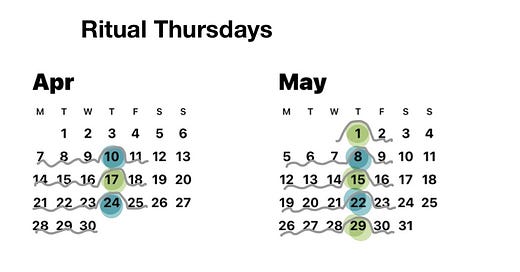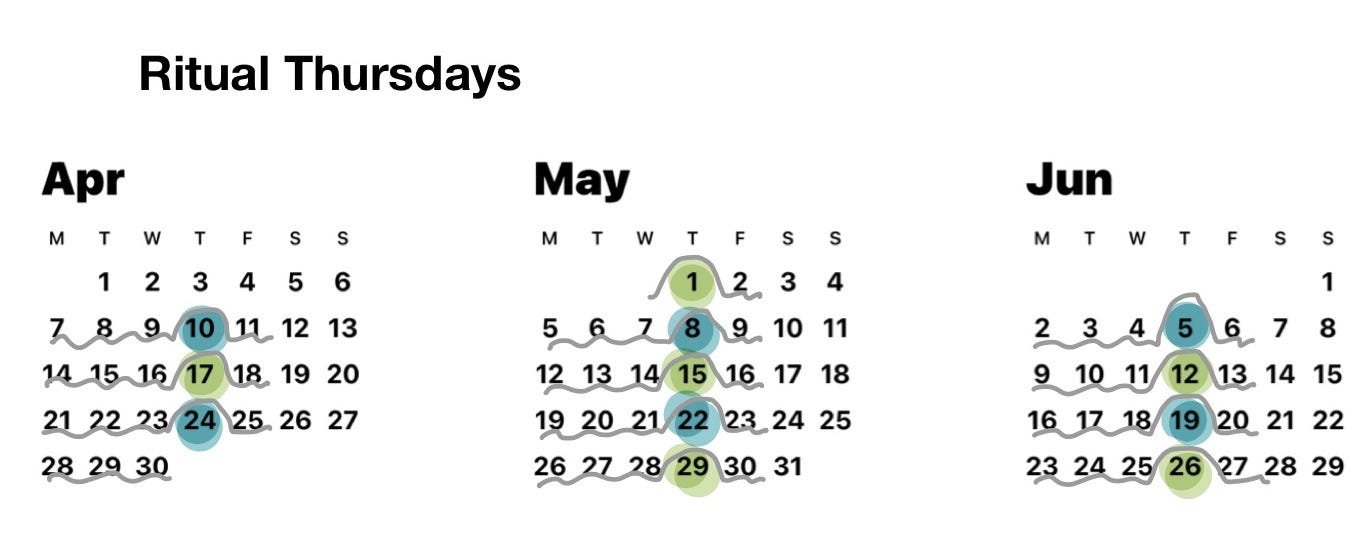Co-creating workplace rituals for that culture thing
Rituals get at that “intangible thing of culture” in an organization. If successful, they can bring extra meaning into the workplace and increase collaboration and productivity.
That’s important against a backdrop of low employee engagement. According to Gallup’s 2024 State of the Global Workplace report, “only 23% of employees are engaged. 62% are ‘not engaged’ and 15% are ‘actively disengaged.’”
What is a workplace ritual?
We might think of “ritual” more broadly as separating from the every day, then going into a place of transition, and finally, returning somehow different—think rights-of-passage, weddings or spiritual observances. According to recent studies on workplace rituals, their characteristics include:
Meaning associated with a communal aspect (we are doing it together, it symbolises something meaningful to us)
Regular cadence (repeatable acts) weekly, monthly, quarterly
Physical element(s) (specific word, action, place, material)
The ritual action/materials/words sit outside of regular “working” activities.
Here are some examples of workplace rituals:
Chipotle staff (who start very early) always gather for a group meal after prepping for the 10:30 store opening.
The “Walmart cheer” for opening the day’s work, patterned after a Japanese tennis-ball maker where the staff started each day with a company cheer
Cambridge Air Solutions staff complete a stretching program at the beginning of every morning meeting
Group “check ins” on a regular basis. E.g. starting meetings with red light, yellow light, green light indicator on how you’re doing with the day/week so far
In Birmingham, Alabama the mayor’s team says the group’s core values out loud in unison at the beginning of big team meetings.
Although workplace rituals are not a cure-all, science suggests they can improve workplace culture. Rituals draw on tradition, superstition, transformation. They can amplify values and meaning.
You can actually co-create workplace rituals in your team or organization to capture these kinds of benefits.
How would you workshop a new ritual?
First, observe. Ask the team what you already do. What do you do as organisation Z that makes you feel most Z-ish when you’re together?
Consider what you already do in the workplace but that sits outside of regular working activities:
What are you already doing to represent your group’s values, exemplify tradition, or that has a bit of “transcendental significance”
Where are you already sharing physical movement together, sharing a process of making, or sharing meals/snacks.
Also consider the scope. Ideally a new ritual won’t ask too much of the team. If it’s light and simple, rather than complicated, it won’t require too much effort, or disrupt. Building on what’s already there can lead to a light touch ritual and make it easy to resource.
Second, generate some ideas. Whether you’re building on what’s already there or introducing something new, there are a range of ritual types and characteristics you might draw from:
Places, spaces, material things (candles, toys, tools etc)
Meals, “breaking bread”
Clothing – distinctive, out of place, coordinated (red shirt day)
Activities such as sport, performance, music, dance, stretching, special handshakes and greetings
Symbolic or ceremonial props: burning a scrap of paper in a fire, ringing a bell
Rituals can be fun, serious, playful or whatever suits your team or organisation.
Once you have some ideas, go ahead an analyse them. Consider which of the ideas capture compelling meaning for your organisation, or represent the values or significance of your work. Test the ideas against the “ritual” framework (repeated here for convenience):
Meaning (such as values) associated with a communal aspect (we are doing it together)
Regular cadence (repeatable acts) weekly, monthly, quarterly
Physical element (specific word, action, place, or material)
The ritual action/materials/words are not functionally connected to work (Rituals are outside of regular “working” activities.)
Third, prototype some of the ritual ideas with small groups to see how they work. Take the best performing idea and try it out in a pilot scheme. It might be useful to present the science behind workplace ritual benefits and ask people to keep an open mind.
As you observe how the ritual works and discuss it with colleagues, consider what goes wrong, and what the stumbling blocks are. Note what goes well and how you can lean into it. Learn from the pilot scheme and refine your approach. After doing an initial testing round, people will become more attuned to the idea of ritual and further ideas might arise.
Fourth, launch and regularise it. Once you’ve tested and refined your ritual, launch it. Accept that the ritual is not a priority for everyone; there will probably be some resistance. Over time some “resistors” may find the ritual actually does create meaning they hadn’t expected.
Please let us know in the comments, does your organisation or team have a workplaces ritual?
Resources:
“Rituals at Work: Teams That Play Together Stay Together” by Kristen Senz Harvard Business Review, March 24, 2022
“Ritual Design: Crafting Team Rituals for Meaningful Organizational Change” By F. Ozenc and Margaret Hagan, Springer Press 2017
Interview with Erica Keswin, author of Rituals Roadmap by Kevin Delaney, Charter Works, October 2021




